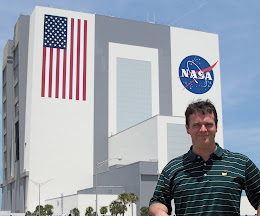Two spacewalking astronauts wrapped up several long awaited chores outside the International Space Station today, the first of two planned walks in space this week.
Shuttle Discovery crew members Steve Bowen and Alvin Drew concluded a six hour, thirty four minute orbital walk in space this afternoon at 5:20 p.m. EST, as the station-shuttle complex flew 222 miles off the Newfoundland coast and out over the northern Atlantic Ocean.
On the agenda first was the installation of the J612 power cable, a back up which runs from the Unity to the Tranquility nodes.
The combined twelve crew members of both the shuttle and station over came a few issues during the spacewalk.
First, Bowen's helmet video camera failed to work. Controllers on the ground in talking with spacewalk coordinator Nicole Stott spent over an hour to troubleshoot the issue. It looked to be working halfway through the walk.

Just over 100 minutes into the spacewalk, the Robotics Work Station computer in the Cupola node shutdown, stopping control of the station's robotic arm.
Arm operators station commander Scott Kelly and Discovery astronaut Mike Barratt were told to switch to the Destiny module's backup work station to resume using the arm to translate Bowen around the truss segment.
As Bowen rode the end of the arm holding the ammonia pump section, Barratt swung the arm over to the Quest airlock. Drew then screwed in four bolts to secure the 780-pound pump module to a storage platform as Bowen held it in place.
Mission Control states that the ammonia pump will be returned back to earth on the final space shuttle mission aboard Atlantis this July.
In the closing minutes of the spacewalk, the astronauts approached the Japanese Kibo module and removed a bottle-styled container and opened the lid.
As the crew inside played The Police's "Message in a Bottle" over the radio communications channel, Drew filled the Japanese metal container with the elements of 'space'.
It will be returned to earth and handed over to JAXA, the Japanese Space Agency, and placed in a museum in Japan in support of space flight. It's designed to inspire future engineers and space voyagers.
"You guys did an excellent job today, you rocked," Stott radioed her crew mates as they concluded work outside the station.
Today's spacewalk was the 154th spacewalk by Americans, Russians, Japanese and Europeans to both construct and maintain the space station. A total 967 hours and 39 minutes of spacewalking since the orbiting lab complex began construction in 1998 have been completed.
This was lead spacewalker Bowen's sixth trip outside a spacecraft and has now logged 41 hours, 04 minutes. For Drew, this was his first trip outside and into the vacuum of space.
NASA's station control room capcom Stan Love spoke to station commander Scott Kelly and Discovery's commander Steve Lindsey at 6:00 p.m. to say that Discovery will receive an extra day docked to the space station.
The extra day in space may mean a special photo opportunity as a Russian Soyuz TMA could undock and fly out to photograph the visiting shuttle as she and several international unmanned craft sit parked at the complex. Russia may be uneasy with the idea.
NASA's Johnson Space Center informed this reporter tonight that NASA is "awaiting a formal decision on a Soyuz fly around which will be made tomorrow at the space station Mission Management Team meeting".
Landing will now be rescheduled for March 8 at about 11:35 a.m. at the Kennedy Space Center.






























